Flash Memory Summit: V-NAND Memory Solutions From Samsung
Offerings include 1Tb V-NAND in single chip, 16TB NGSFF SSD, Z-SSD and key value SSD
This is a Press Release edited by StorageNewsletter.com on August 18, 2017 at 2:42 pmSamsung Electronics Co., Ltd. announced V-NAND (Vertical NAND) memory solutions and technology that will address the pressing requirements of next-generation data processing and storage systems.
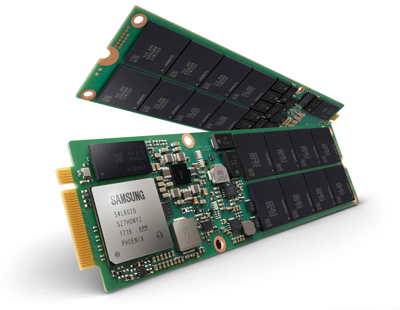
With the rapid increase of data-intensive applications across many industries using artificial intelligence and IoT technologies, the role of flash memory has become critical in accelerating the speed at which information can be extracted for real-time analysis.
At the inaugural Samsung Tech Day (*) and this year’s Flash Memory Summit (**), the company showcased solutions to address next-generation data processing challenges centered around the firm’s latest V-NAND technology and an array of SSDs. These solutions will be at the forefront of enabling today’s data-intensive tasks such as HPC, machine learning, real-time analytics and parallel computing.

“Our new, highly advanced V-NAND technologies will offer smarter solutions for greater value by providing high data processing speeds, increased system scalability and ultra-low latency for today’s most demanding cloud-based applications,” said Gyoyoung Jin, EVP, head, memory business, Samsung Electronics. “We will continue to pioneer flash innovation by leveraging our expertise in advanced 3D-NAND memory technology to enhance the way in which information-rich data is processed.“
Front and rear
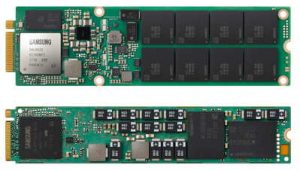
Company heralds era of 1Tb V-NAND chip
The company announced a 1Tb V-NAND chip that it expects to be available next year. Initially mentioned in 2013, during unveiling of the industry’s first 3D NAND, it has been working to enable its core memory technologies to realize 1Tb of capacity on a single chip using a V-NAND structure.
The arrival of a 1Tb V-NAND chip next year will enable 2TB of memory in a single V-NAND package by stacking 16 1Tb dies and will represent one of a important memory advances of the past decade.
NGSFF (Next Generation Small Form Factor) SSD
to improve server storage capacity and IO/s
The company is sampling a first 16TB NGSFF SSD, which will improve the memory storage capacity and IO/s of today’s 1U rack servers. Measuring 30.5x110x4.38mm, the firm’s NGSFF SSD provides hyper-scale data center servers with substantially improved space utilization and scaling options.
Utilizing this NGSFF drive instead of M.2 drives in a 1U server can increase the storage capacity of the system by four times. To highlight the advantages, the company demonstrated a reference server system that delivers 576TB in a 1U rack, using 36 16TB NGSFF SSDs. The 1U reference system can process about ten million random read IO/s, which triples the IO/s performance of a 1U server equipped with 2.5-Inch SSDs. A petabyte capacity can be achieved using only two of the 576TB systems.
The company plans to begin mass producing its first NGSFF SSDs in the fourth quarter of this year, while working to standardize the form factor with industry partners.
Z-SSD
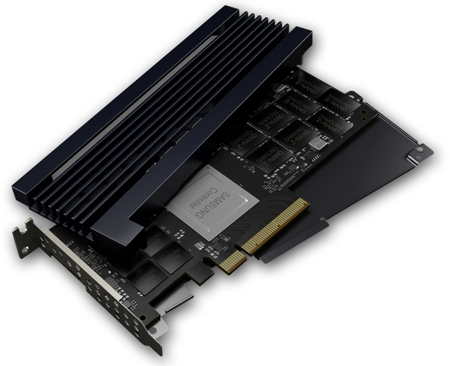
Z-SSD: optimized for systems requiring fast memory responsiveness
Following last year’s introduction of its Z-SSD technology, the firm introduced its first Z-SSD product, the SZ985. Featuring low latency and performance, the Z-SSD will be used in data centers and enterprise systems dealing with large, data-intensive tasks such as real-time big data analytics and performance server caching. The company is collaborating with several of its customers on integrating the Z-SSD in upcoming applications.
The SZ985 requires only 15 microseconds of read latency time which is approximately a seventh of the read latency of an NVMe (***) SSD. At the application level, the use of firm’s Z-SSDs can reduce system response time by up to twelve times, compared to using NVMe SSDs.
With its fast response time, the Z-SSD will play a pivotal role in eliminating storage bottlenecks in the enterprise and in improving the TCO.
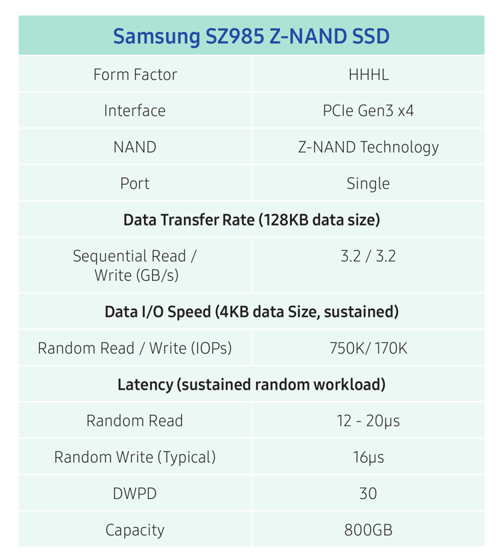
Approach to storage with proprietary key value SSD technology
The company also introduced a new technology called Key Value SSD. The name refers to an innovative method of processing complex data sets. With the increasing use of social media services and IoT applications, which contribute to the creation of object data such as text, image, audio and video files, the complexity in processing this data increases substantially.
Click to enlarge
Today, SSDs convert object data of widely ranging sizes into data fragments of a specific size called blocks. The use of these blocks requires implementation processes consisting of LBA (logical block addressing) and PBA (physical block addressing) steps.
However, the company’s Key Value SSD technology allows SSDs to process data without converting it into blocks. Firm’s Key Value instead assigns a ‘key’ or specific location to each ‘value,’ or piece of object data – regardless of its size. The key enables direct addressing of a data location, which in turn enables the storage to be scaled. Key Value technology enables SSDs to scale-up (vertically) and scale-out (horizontally) in performance and capacity. As a result, when data is read or written, a Key Value SSD can reduce redundant steps, which leads to faster data inputs and outputs, as well as increasing TCO and extending the life of an SSD.
Click to enlarge
(*) Samsung Tech Day hosted at the company’s Silicon Valley HQs on Monday August 7th, showcased Samsung@the Heart of Storage and provided insights into the firm’s plans to deliver IT products that support the big data explosion, give greater access to massive real-time data sets, and provide real-time, fast data capabilities. The event also hosted an executive, customer and analyst panel, and displayed product demos across Samsung’s comprehensive product ecosystem.
(**) Flash Memory Summit (FMS), produced by Conference ConCepts, showcases the mainstream applications, key technologies and vendors that are driving the multi-billion dollar non-volatile memory and SSD markets. FMS is reportedly the world’s largest event featuring the trends, innovations, and influencers driving the adoption of flash memory in demanding enterprise storage applications, as well as in smartphones, tablets, and mobile and embedded systems.
(***) Often shortened as NVMe, NVM Express (Non-Volatile Memory Express) is a high performance, scalable host controller interface with a streamlined ‘register and command’ set that has been optimized for enterprise and client systems using PCIe SSDs.








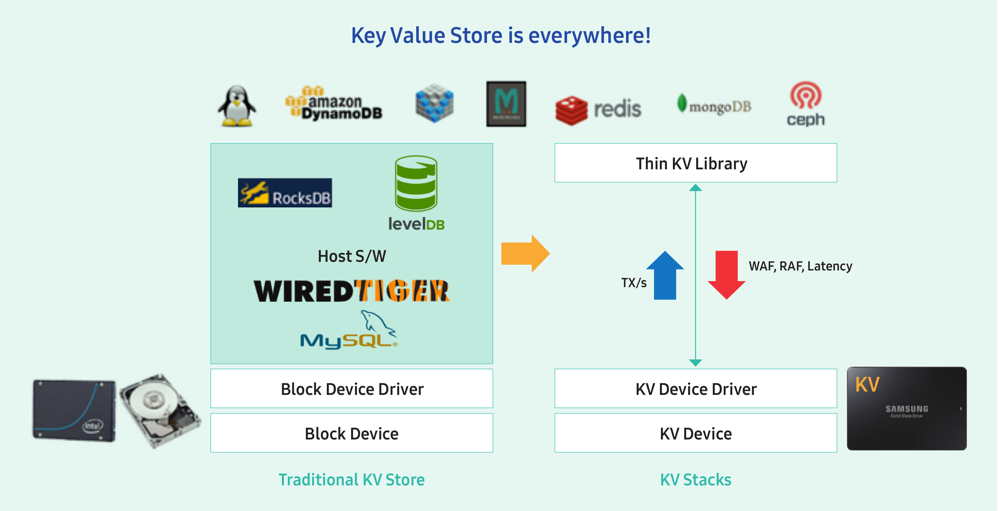
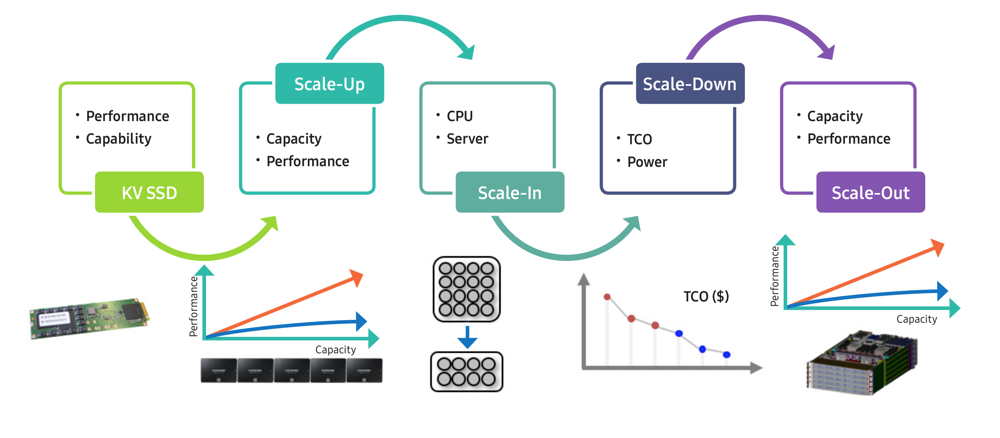




 Subscribe to our free daily newsletter
Subscribe to our free daily newsletter


